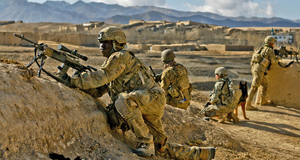From Nostalgia to Post-Traumatic Stress Disorder: A Mass Society Theory of Psychological Reactions to CombatShakespeare (1603 / 1993) affixed descriptions of psychological disorder to many of his most famous characters. Recall that his Scottish Army General, Macbeth, suffered hallucinations and nightmares as he became overwhelmed with guilt after, with the aid of his wife, he devised and executed a plot to kill King Duncan in order to facilitate his own selfish aspirations. Even Lady Macbeth displayed comorbid symptoms of dissociation and obsessive-compulsive behavior afterward as she began to sleepwalk and continually wring her hands, to make them clean, until she took her own life. In times barely removed from feudalism, when the preponderance of men were intimately or otherwise familiar with pain and interpersonal violence, great writers took the dysfunctions observed in their fellow men and applied them to their characters. Subsequently, the observer was presented with a situation where an otherwise powerful and rational human being succumbed to the horrors of his/her own psyche. These are necessarily quite intimate narratives that allowed readers to connect with the ailing warriors; not comparable in any way to the common “tough guy” image of today’s cinematic fiction. Regardless of the available literature which conveyed that combat stress was quite natural, at this time and for centuries hence, soldiers were nonetheless held to an archaic standard of mental toughness. This expectation was eloquently outlined by the French knight Geoffroi de Charny in his 14th Century treatise The Book of Chivalry. Therein, the author warned young soldiers that they would see people killing each other, fleeing, dying, and being taken prisoner and that their friends would die beside them. He cautioned that it may be tempting to escape in dishonor on the backs of their horses, but that he who stays would win eternal honour. In order to defeat the melancholy associated with combat hardships, such as sleep deprivation, hunger, and exhaustion, Charny prescribed an unyielding devotion to chivalric duty and faith in God (Kaeuper & Kennedy, 1996).One can only speculate as to the efficacy of this treatment. Military doctors made the first concerted attempts to categorize and diagnose the manifestations of acute combat reaction for which Johannes Hofer had championed the term “nostalgia” in his 1688 medical dissertation. This classification survived through the end of the Seven Years War and described the disorder as consisting of depression, angst, and exhaustion. Since the symptoms were believed to be associated with soldier’s longing to return home during extended campaigns (not to actual battlefield experiences), both the French and Germans classified the malady as “homesickness”; maladie du pays and heimweh respectively. In Spain, the same symptoms would come to be known as estar roto (“to be broken”). This notion persisted through much of the Napoleonic era (Charvat, 2010). Non-Combat Related PTSDIt is important to note that post-traumatic stress reactions to crises are not, nor have they ever been, quarantined to the field of battle. Though war veterans often have unique experiences compared to those of their civilian contemporaries, debilitating psychological ailments are a common adaptive response to traumatic events. There are myriad forms of stress which can manifest into hysterical reactions consistent with the clinical diagnoses of PTSD. The commonality therein is that wherever and however they occur, the events must be catastrophic stressors outside the scope of normal human experience (American Psychiatric Association, 2000). However, before the dawn of psychiatry, neurologists simply labeled various post-traumatic syndromes according to the nature of the event which precede the onset of symptoms in feeble attempts to establish causation. In 19th Century Victorian Britain, as advancements in transportation and communication were bringing the world together like never before, survivors of railway accidents often reported suffering from chronic and severe anxiety. Many were subsequently diagnosed with “railway spine,” which was accompanied by fatigue, trembling, and anxiety. In 1865, famed author Charles Dickens reported such symptoms after being involved in a railway accident in England (Dickens, 1880 / 2008). At the time, it was believed that the condition was the result of a violent impact to the nerves within the spine. However, a French neurologist, Jean-Martin Charcot, introduced the notion of an underlying neurological disease known as hysteria, which was quickly abandoned by mainstream medical professionals. Though time would reveal that Charcot happened to be on the right track, his theory was avoided due to the concurrent rise of welfare reform in Europe. Germany had very recently become the first country to offer state-funded disability compensation. Consequently, a psychologist by the name of CTJ Rigler coined the term “compensation neurosis,” popular among railroad lawyers, as a comprehensive placeholder for these cases; with “compensation” referring to a new law which allowed people to sue for damages as a result of emotional suffering (Rosen, pp. 214-216). He and others regarded such traumatic symptoms as the inventions of a litigious bunch of malingerers. Therefore, this represents a transitional period wherein the people simultaneously handed-off responsibility to government and industry, while distancing themselves from their fellow citizens. Given the “macho” nature of their occupation, veterans would find even more difficulty in having stress reactions recognized as legitimate disabilities. The Birth of Modern WarfareThe evolution of public perception in American society regarding veterans who suffer from PTSD resembles Foucault’s (1961/1965) analysis of insanity throughout the development of Western civilization. He wrote of the Ships of Fools into which insane persons were corralled and sent adrift. As Leprosy had only recently vanished, the mad assumed the social role of the leper. During the Renaissance era, there was a certain amount of romance attached to the notion of an emotionally unstable and abandoned individual finding his peace with nature and the Judeo-Christian god (pp. vi-vii, 7-8). These sentiments were transplanted and survived into the more volatile years of the United States. For instance, unit medical staffs became utterly overwhelmed during the American Civil War as thousands of troops were diagnosed with “soldier’s heart.” The Union Army alone reported more than 5,200 cases of “nostalgia” and another 2,600 diagnoses of insanity; both of which are likely gross underestimates (Charvat, 2010). Subsequently, many of the afflicted were placed in rail cars with the name of their home towns or states pinned to their uniforms. Others were simply sent to wander the countryside until they succumbed to thirst, hunger, or exposure (Bentley, 2005). If they could have been ignored, perhaps they would have been collectively forgotten. Importantly, it was around the end of the War Between the States that citizens became moved (or at least aggravated) by the plight of their warriors. According to Bentley (2005), the legion of wandering veterans became such a cause for concern that public demand prompted the establishment of the first American military hospital for the insane in 1863. Therein, the people deflected personal responsibility for their veterans, which is quite astonishing considering that the war had been fought on American soil and, in some cases, literally in citizens’ backyards. With President Lincoln’s promise, the federal government assumed an official stance in caring for the nation’s veterans; though psychological reactions to combat were still not accepted as legitimate disabilities. Rather, the hospital was regarded as a sort of halfway house for traumatized veterans until they could be claimed by a family member. Similarly, Foucault (1961 /1965) alluded to the use of the Commandery of Saint Louis which was to be used as a rest home for military invalids, but wherein the insane were also confined (p. 39). Technological advances continued to make each generation of soldiers the most accurate and destructive up to that point in history. Consequently, psychological stress reactions became exceedingly prevalent to the point of being unmanageable. Nevertheless, most military commanders and politicians continued to believe that hysterical reactions to trauma were indicative of a lack of discipline; contending that those who suffered from such symptoms were malingerers. Though the concept had existed previously, Pierre Janet became the first to clearly explain that dissociation was a direct psychological defense against overwhelmingly stressful experiences and that it plays an important role in post-traumatic stress responses (van der Kolk, Brown, & van der Hart, 1989). However, this information did not travel in any expeditious manner through the impermeable layers of bureaucracy. Nonetheless, during its war with Japan in 1905, the Russian Army became the first in history to affirm that mental breakdown, a.k.a. “battle shock,” shared a causal relationship with combat stress. Military psychiatry was born with Russia’s attempts to diagnose and treat battle shock; which resulted in roughly 2 of every 10 afflicted soldiers being deemed capable of returning to the front (Gabriel, 1987, pp. 109-112). This was a remarkable progressive move toward recognition of battlefield stress as a legitimate ailment; even if the ultimate goal was merely to return soldiers to combat quickly. Nonetheless, such advances in treatment would remain decades in the future for “malingering” American troops. The uniquely brutal nature of trench warfare in World War One brought combat stress and governmental ignorance to the forefront. One of the most disturbing examples occurred when 300 British soldiers suffering from battlefield trauma were executed for cowardice. It would be nearly one hundred years before the United Kingdom would grant them posthumous pardons (BBC, 2006). Rather than build upon the compendium of extant medical literature concerning the link between battlefield trauma and psychological disorder, researchers of the era started from scratch and initially attributed the condition to the new weaponry of war; namely large-caliber artillery and explosives. The unfounded belief that the impact of shells produced concussions capable of disrupting neural function birthed the term “shell shock”; an obvious confusion of correlation with causation. Ultimately, about 8% of all troops sent to fight in Europe were removed from action for psychological reasons. By the end of WWI, clinicians began to realize that shell shock was not actually caused by physical damage to the brain. However, it was still widely believed that such conditions only afflicted men of exceptionally weak character. Utilizing a different approach than their predecessors, yet arriving at the same near-sighted conclusion, physicians contended that the solution was to develop more thorough military entrance screening processes. Particular attention was paid to sifting through draftees in order to mediate the potential for emotional breakdown. With the aid of psychiatric testing, the military rejected some five million men from service on this presumption (Mitchell, 2010).Continued on Next Page » Suggested Reading from Inquiries Journal
Inquiries Journal provides undergraduate and graduate students around the world a platform for the wide dissemination of academic work over a range of core disciplines. Representing the work of students from hundreds of institutions around the globe, Inquiries Journal's large database of academic articles is completely free. Learn more | Blog | Submit Latest in Sociology |
















